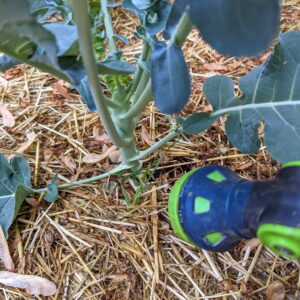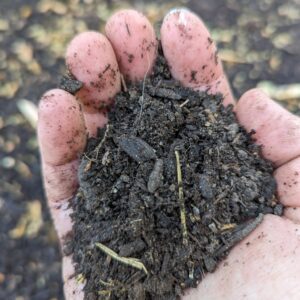The thing about offering advice on watering plants is that there is not a one size fits all solution. Variables such as the amount of sun, soil type, and different plants will have an impact on watering needs. However, that is not to say there aren’t some general guidelines when it comes to water. We are here to help with watering tips for summer plants.
General Watering Tips and Guidelines
- The best time to water your garden plants including summer bulbs and perennials is in the morning. Watering early in the day reduces the amount of evaporation which leads to more effective absorption. It also helps to prevent fungal leaf diseases as the water is absorbed into the soil and will dry off from the leaves early in the day.
 It is best to water directly into the soil near the base of the plant. Avoid watering directly onto the plant as this can cause fungal leaf problems.
It is best to water directly into the soil near the base of the plant. Avoid watering directly onto the plant as this can cause fungal leaf problems.- Deep watering is ideal. Therefore, it is best to have a slower stream of water at the base of the plants for a longer amount of time. Compared to having a fast quick burst of water that only gets the surface wet. By watering at a slower rate for a longer duration this encourages a deeper root system. Over time plants that are deeply watered will require water on a less frequent basis.
- Potted plants will require more frequent watering than plants in the ground. Certain materials, such as clay and terracotta pots dry out rather quickly, therefore, flowers in those types of pots may need water multiple times a day.
Summer Watering FAQs
Q. If I can’t water in the morning is it ok to water at night?
While the ideal time to water is early in the morning this won’t work for everyone’s schedule. Also, during the dog days of summer, certain plants may require water more than one time per day. Yes, watering in the early evening is ok, even if it’s not the best time. Watering at night does provide cooler temperatures which can provide the benefit of the plants not soaking it all up too quickly. However, avoid watering the leaves with nighttime watering as this is the prime time for fungal leaf diseases to occur.
Q. How do I know if my summer plants need water?
The best way to know if summer plants need water is to check the soil. Stick your finger  or hand into the soil and see if it feels moist. If the soil feels dry and crumbly, it could use a good healthy drink of water. Soil that feels slightly damp can wait until the next day to be checked, and water if it feels dry that day. If the soil is holding water and is saturated it is best to let it dry out completely until the next watering. Soil that is saturated and holds water should be monitored. If the soil does not drain and plants aren’t growing in that area, it most likely will need to be amended in the future. Amend poorly draining soil by adding organic matter such as composted manure and peat moss.
or hand into the soil and see if it feels moist. If the soil feels dry and crumbly, it could use a good healthy drink of water. Soil that feels slightly damp can wait until the next day to be checked, and water if it feels dry that day. If the soil is holding water and is saturated it is best to let it dry out completely until the next watering. Soil that is saturated and holds water should be monitored. If the soil does not drain and plants aren’t growing in that area, it most likely will need to be amended in the future. Amend poorly draining soil by adding organic matter such as composted manure and peat moss.
Another way to tell if your plants need water is to look at the foliage. Is it droopy, wilting, or crispy looking? A perennial that is really good at telling you it wants water is Astilbe. Their leaves start to dry up, and will visibly look crispy–if you see this on your astilbe give them a good healthy drink of water.
Q. Is it possible to water too much?
Yes, absolutely, too much water can be as devastating as too little water. Unfortunately, plants that have received too much water often will display the same symptoms as plants that receive too little water. Plants like all living things need water but also air, if the roots are always wet, they can’t breathe. Therefore, it is not advised to simply water every day no matter what. Checking the soil, paying attention to local temperatures, and looking closely at your plants is the best way to water safely.
Q. Can I water flowers and vegetables with a sprinkler?
Sprinklers are used to water new and established lawns. They also make for inexpensive fun for everyone on a hot day. However, they aren’t the ideal way to water flowers and vegetables. Watering with a sprinkler does not provide deep watering, and also can cause fungal leaf problems. However, if watering flowers and vegetables with a sprinkler is the only option due to time constraints, it is better than no water. If you are watering garden beds with a sprinkler, be sure to check that the soil is getting fully saturated and not just hitting the surface. Also, if watering with a sprinkler is the only option it should be done in the morning.
fun for everyone on a hot day. However, they aren’t the ideal way to water flowers and vegetables. Watering with a sprinkler does not provide deep watering, and also can cause fungal leaf problems. However, if watering flowers and vegetables with a sprinkler is the only option due to time constraints, it is better than no water. If you are watering garden beds with a sprinkler, be sure to check that the soil is getting fully saturated and not just hitting the surface. Also, if watering with a sprinkler is the only option it should be done in the morning.
Q. Should dormant flower bulbs be watered? 
Flower bulbs are generally very easy to grow. Summer bulbs like calla lilies, canna lilies, and elephant ears, tend to be quite thirsty once they are growing. However, when bulbs are first planted and are dormant still, the water should be kept to a minimum. When dormant flower bulbs such as dahlias are watered frequently prior to sprouting this can cause the bulbs to rot. Until sprouts are seen above ground on newly planted summer bulbs it is best to err on the side of drier soil.
Q. How to water bare root perennials?
Newly planted perennials that are grown from a bare root will require regular water.  When these plants are first getting established it is important to keep the soil evenly moist. While, they may not need water every day, if the soil feels dry be sure to give the plants a drink of water. Starting bare-root perennials in small nursery pots before planting them in the ground can help to monitor the amount of water needed when they are young. When bare root perennials are started in pots the soil is easier to test if it is dry vs if they are in the ground. Even drought-tolerant perennials like sedum will require water on a regular basis when they are getting established in the garden.
When these plants are first getting established it is important to keep the soil evenly moist. While, they may not need water every day, if the soil feels dry be sure to give the plants a drink of water. Starting bare-root perennials in small nursery pots before planting them in the ground can help to monitor the amount of water needed when they are young. When bare root perennials are started in pots the soil is easier to test if it is dry vs if they are in the ground. Even drought-tolerant perennials like sedum will require water on a regular basis when they are getting established in the garden.
Watering Is Patience, Knowledge, and Attention
To have success with newly planted flower bulbs and perennials water is a critical factor. Patience is required to wait until the soil and plants tell you they need water. Knowledge of what plants need to thrive is necessary to ensure they get the proper amount of water. Attention is really the most important aspect. Paying attention to how moist the soil is, what the plants look like, and what they need. Even the best gardeners may over or underwater on occasion. The plants will tell us when we make a mistake, they are here to teach us, and we are ready to learn!
One last point, while the morning is the best time to water, if your plants look droopy in the middle of a hot summer day, give them a drink–they will appreciate it!


